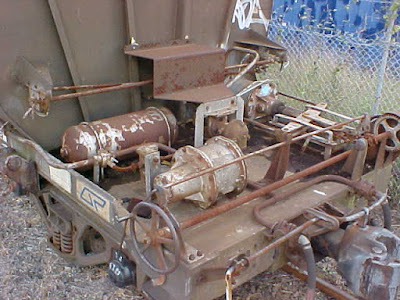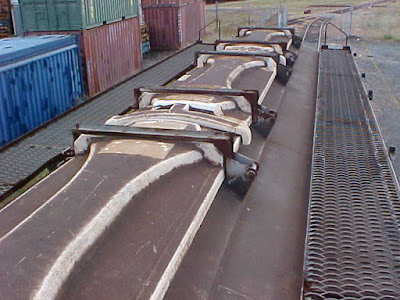A prototype aluminium bottom
discharge wagon entered service in 1965 as the VGY class, the class consisted
of one wagon # 33769. Details are; Tare 12t, the gross weight on all lines
40.6t, some “B” lines 42.6t and “S” & “A” lines 44.7t. The unit length was
2.5, the same as the WH and WHE wagons. The draw pack consisted of
self-container buffers, Alliance auto couples with transition couplings, D1
drawgear class. The wagon rolled on QR 22 bogies with 850 mm wheels and had a
cubic capacity of 42.2 m³. Drawing P 212 suggest this was a Com.Eng built
wagon. Filling the wagon must have been a pain, five hatches760 mm dia. on top
of the wagon. The WH and WHE wagons with traps would of been much easier, undo
the trap on one side, pull back to other side and the whole wagon was exposed
for loading.
Dalby
Willowburn May
1993
This pathed the way for
the QGX wagon. The class numbers was built over many contracts.
Details are; Tare 12.2t, gross
weight on all lines 40.6t, some “B” lines 42.6t and “S” & “A” lines 48.7t.
The unit length was 2.5, the same as the WH and WHE wagons. The draw pack
consisted of self-container buffers, National rubbers Sharon auto couples with
transition couplings, D1 drawgear class. The wagon had a cubic capacity of
46.72 m³. The three fiberglass hatch gave an opening of 7 620 mm x 685mm. At first
the wagons only had one walkway for loading. A second was added with later
contracts in 1976, earlier wagons had the walkway added as the wagon passed
through the workshops. From 1971 a modification was made to the centre hatch,
wagons with modified hatch were recoded to QGX/C. The program lasted to 1979
and all wagons were coded back to QGX.
The wagons were fitted
with a manually operated “Empty & Loaded” brake lever. When the wagon was empty, the lever was set
to “E” and when loaded the lever was changed to “L”.
Type “A” Contracts details.
|
Year
|
Numbers
|
#
Built
|
Bogies
|
Builder
|
|
1967
|
33780
– 33829
|
50
|
QR
22
|
Scotts,
Ipswich
|
|
1968
|
33830
- 33904
|
40
|
QR
16 A
|
Scotts,
Ipswich
|
|
1972
|
34617
- 34666
|
50
|
QR
16 A
|
Steelweld
- Wacol
|
|
1972-73
|
36626
- 36675
|
50
|
QR
36
|
Steelweld
- Wacol
|
|
1973
- 74
|
37220
-37259
|
75
|
QR
36
|
Steelweld
- Wacol
|
|
1976
|
39131
– 39180
|
50
|
QR
36
|
Com
Eng - Salisbury
|
|
1980
|
40973
- 41022
|
50
|
QR
16A
|
Vickers
- Ipswich
|
|
|
|
365
|
|
|
QGX
QGX/C (Mid
1970’s Logo added to the side).
In 1976 some “QGX” wagons
have been modified and re classed “QGXM” for the conveyance of malt. The
modification was the provision of plastic foam seals around the hatch coaming.
The wagons were also marked “BULK MALT” on the side in 12” (305 mm) block letters
instead of “BULK GRAIN” as previously. The wagons so re-classified must remain
in use solely for the conveyance of Bulk Malt. Bulk Malt was also carried in HJM
wagons (1968 – 25849, 25887, 25777, 25883) and PF 34269 (1968) wagons between
Toowoomba and Cairns.
During their service
life, fumigation outlets, protector plates over control rods were added to the
wagons.
QGX 33786 as
delivered to Service.
“A” end of Type
“A” wagons (2003)
“B” end of Type
“A” wagons.
Roof hatches
Type “A” wagons.
|
Year
|
Numbers
|
#
Built
|
Bogies
|
Builder
|
|
1984
|
43580
- 43659
|
50
|
QR
36 A
|
Com
Eng - Salisbury
|
|
1985
|
44947
- 44996
|
50
|
QR
36 A
|
Vickers
- Ipswich
|
|
|
|
100
|
|
|
QGX 43618
Gladstone Aug 85. J.Buckland Photo.
With the introduction for
higher carry capacity coal wagons in Central Queensland, many of the lighter carry
capacity coal wagons were allocated other work. Coal wagons had been used in
the grain traffic before in peak seasons.
VAO coal wagon
being used for grain traffic.
With loaders being 3.5 metres above
the ground became a WHS issue. When wagons were loaded, they were often controlled
shunted on a grade or pushed by a tractor or vehicle, at times loaders were
knocked to the ground. The coal wagons had a higher
carry capacity and stayed within the limits for “A” lines making them more
suitable. This saw a decline in the number of QGX required with only 355 wagons
in service in 1998, with the introduction of the VGH and VGK class wagons with air operated loading hatches in
2000, the numbers dropped quickly. By 2002, 36 remained in service for the
Tolga to Kingaroy peanut traffic. The peanut traffic ceased in October 2003,
with the last consignment of 11 wagons arriving at Kingaroy on 14th
October 2003. A few of the class can be
found in Museums around the state. QGA 33885 at Capella, 33889 is in a mural
with three other wagons at Clermont. QGA 44981 is part of the QR Heritage
collection.
“A” end “B” Type Wagons.
“B” end “B”
type wagons
Roof Hatch “B”
type wagons (2003)
QGX 43825 Roma
Street June 1985
Ipswich Mar 92
QGX wagons being loaded on the Downs.
























Outstanding history and photo coverage Arthur. And I like the models too. The end pipe work is excellent.
ReplyDelete